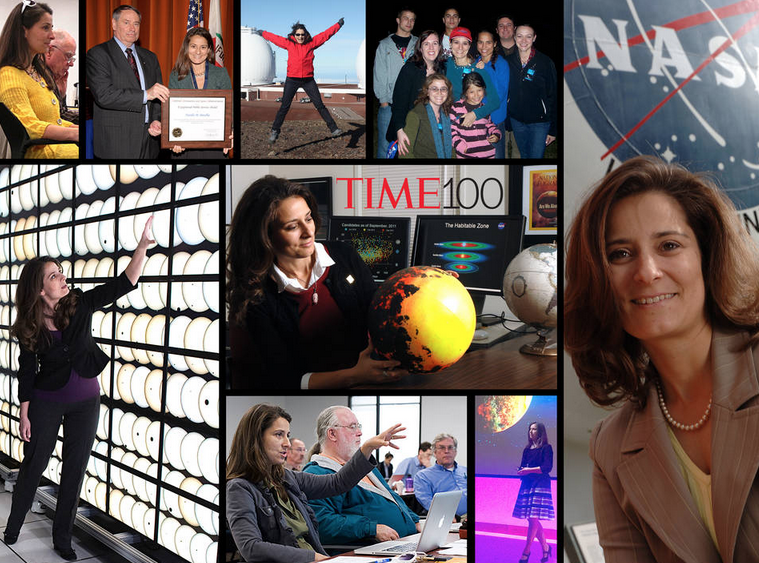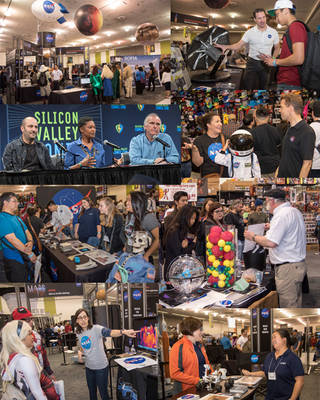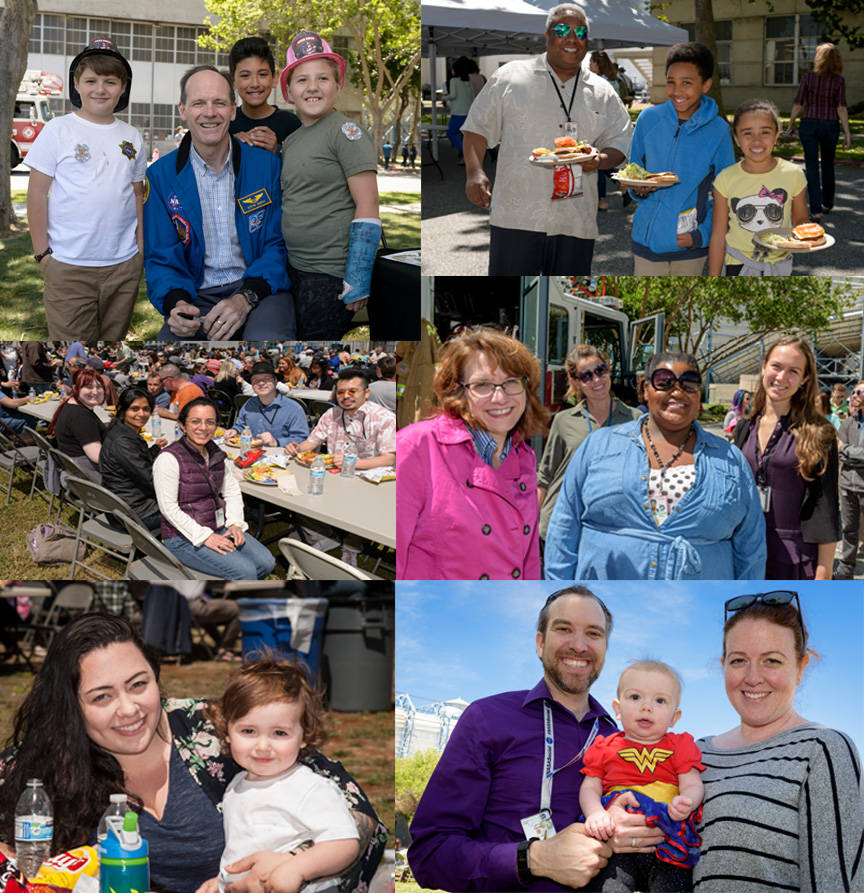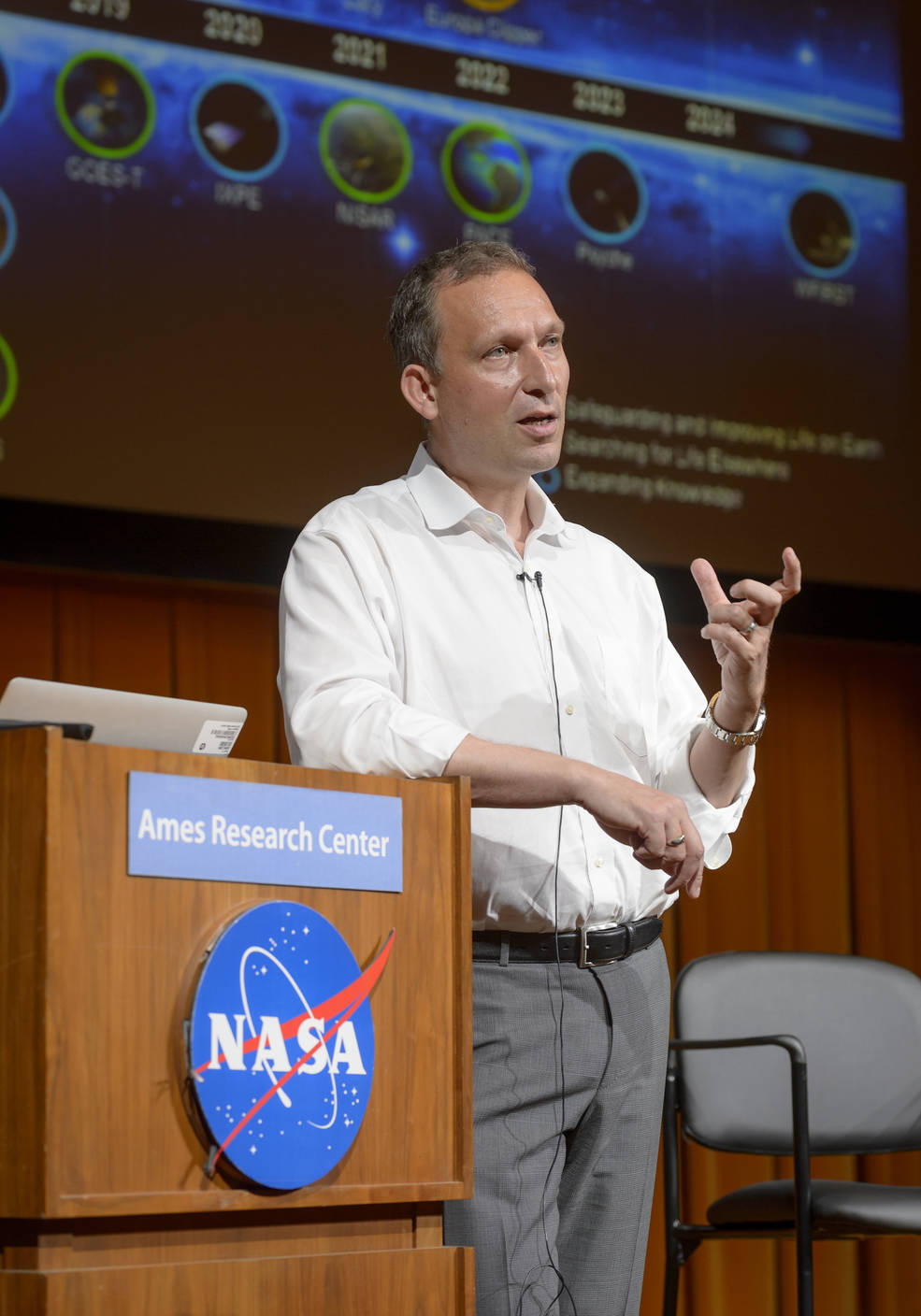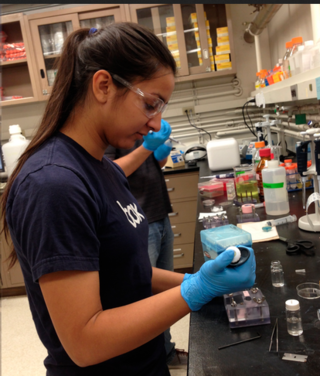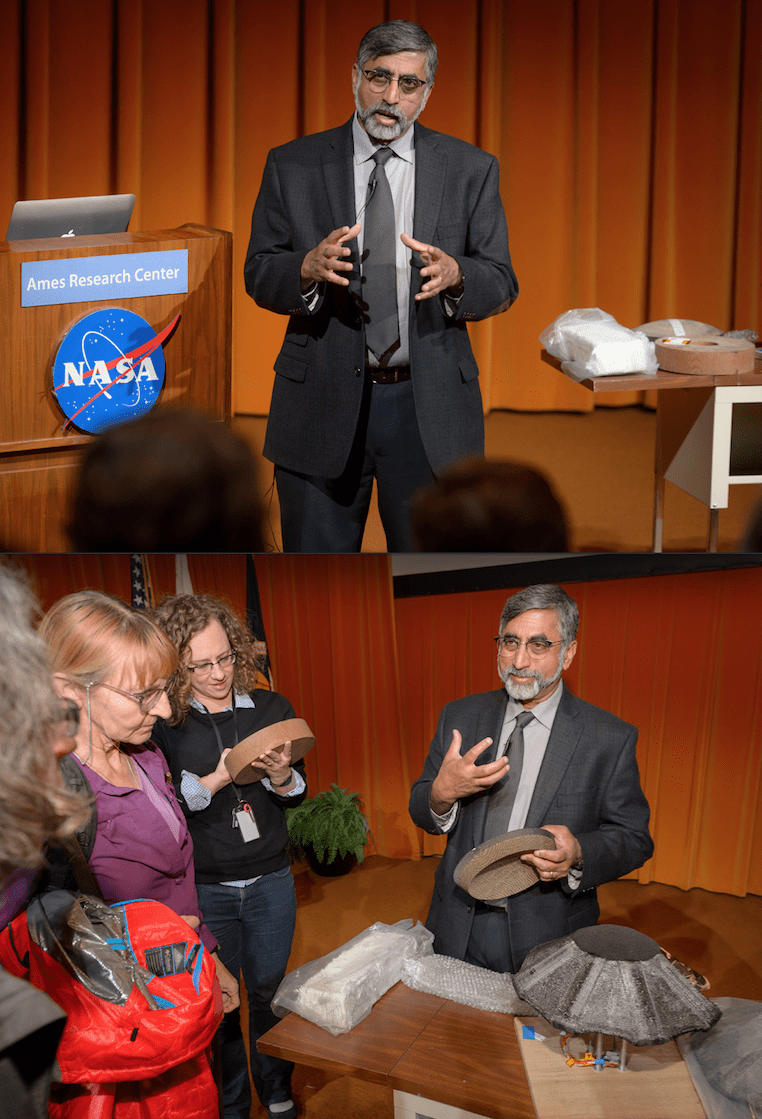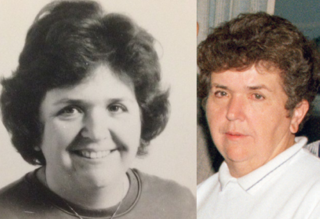Kepler Scientist on Time Magazine’s Most Influential List
by Michele Johnson
A NASA scientist searching for other worlds has been named one of the most influential people on our world. Time magazine has named Kepler project scientist Natalie Batalha to the Time 100, its annual list of the 100 most influential people on Earth. Natalie shares this honor this year with planet-hunters Guillem Anglada-Escudé of the Queen Mary University of London, who discovered an Earth-size planet orbiting Proxima Centauri in 2016, and Michaël Gillon of the University of Liège in Belgium, who recently announced the discovery of seven Earth-size planets orbiting TRAPPIST-1 using NASA’s Spitzer Space Telescope.
Batalha leads the science investigation effort for Kepler – NASA’s first mission to find Earth-size planets beyond our solar system. Kepler is seeking to find how common planets are in other stars’ “habitable zones,” the range of distances from each individual star where temperatures could allow liquid water to pool on the surface of the planet without freezing or evaporating. Working at NASA Ames, Batalha has been a leading figure of the mission since she joined the team in 1999.
“NASA is incredibly proud of Natalie. Her leadership on the Kepler Mission and the study of exoplanets is helping to shape the quest to discover habitable exoplanets and search for life beyond the solar system,” said Paul Hertz, Astrophysics division director at NASA Headquarters, Washington. “It’s wonderful to see her recognized for the influence she has had on the world – and on the way we see ourselves in the universe.”
Time magazine’s Editor-in-Chief Nancy Gibbs has explained, “Each year our Time 100 list lets us step back and measure the forces that move us. … One way or another they each embody a breakthrough: they broke the rules, broke the record, broke the silence, broke the boundaries to reveal what we’re capable of.”
Time ran a short article on Batalha’s accomplishments. Batalha is the first woman at NASA to receive the Time 100 designation.
“I’m honored to be part of the TIME 100 and feel strongly that recognition belongs to the entire team of scientists and engineers who opened our eyes to the large number of potentially habitable worlds that populate the galaxy,” said Batalha. “Searching for potentially habitable worlds makes one appreciate just how precious living worlds are. I hope that the discoveries from the Kepler spacecraft inspire people to learn more about other planets, and, in turn, make us love this one all the more.”
Batalha holds a bachelor’s degree in physics from the University of California (UC), Berkeley, and a doctoral degree in astrophysics from UC Santa Cruz. Batalha started her career as a stellar spectroscopist studying young, sun-like stars. Her studies took her to Brazil, Chile and, in 1995, Italy, where she was present at the scientific conference when the world learned of the first planet orbiting another star like our sun.
In 1999, after inquiring about the challenges that star spots present in distinguishing signals from transiting planets, Batalha began working on the Kepler Mission with William Borucki, visionary and principal investigator of Kepler, at Ames. Today, Batalha leads the Kepler team in determining the fraction of stars in our Milky Way galaxy that have planets that might be places for life as we know it. She participates on numerous scientific advisory panels to chart the future of NASA’s astrophysics research to find life beyond the solar system and answer the question: are we alone?
“I am really delighted that Natalie is being honored by TIME magazine. She has made major contributions to the Kepler Mission throughout its development and operation,” said Borucki. “Natalie’s collaborative leadership style, and expert knowledge of the population of exoplanets in the galaxy, will provide guidance for the development of successor missions that will tell us more about the habitability of the planets orbiting nearby stars.”
Batalha began her undergraduate studies as a business major but discovered her passion in a physics lecture with the realization that numbers can describe the physical world — the colors of a rainbow, for example, expressed by an equation. She saw her calling after experiencing the thrill of discovery studying data from research telescopes. The excitement of participating in the scientific process and seeing something no one had yet seen before had her hooked.
Curiosity and passion for science did not stop with Batalha. Her oldest daughter is a Ph.D. student studying the atmospheres of distant planets—one of the many things NASA’s next flagship mission, the James Webb Space Telescope, will study. Batalha grew up in Northern California where she lives today with her family.
The list, now in its fourteenth year, will appear in the May 1, 2017, issue of TIME, available on newsstands on Friday, April 21, 2017 and now at time.com/time100.
Kepler has identified more than 5,100 possible exoplanets and verified more than 2,500 as bona fide planets. Of these, a dozen are Earth-like in size and orbit in their stars’ habitable zones.
Ames manages the Kepler mission for NASA’s Science Mission Directorate.
For more information on NASA’s Kepler mission, visit: https://www.nasa.gov/kepler
For more information about NASA’s search for life, visit: https://www.nasa.gov/content/the-search-for-life
NASA Technology Meets Hollywood Sci-Fi and Fantasy Fan Culture
by Ruth Dasso Marlaire
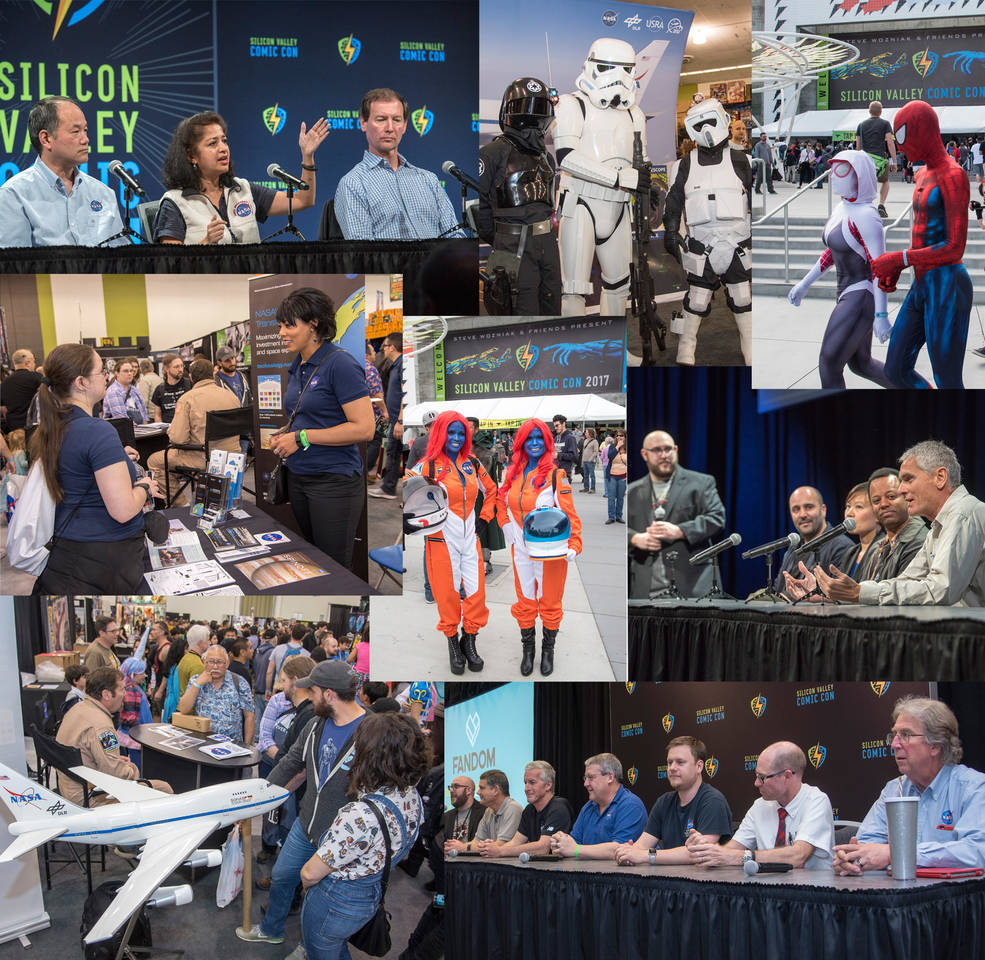
NASA science superstars met science fiction superstars last week at the Silicon Valley Comic Con held at the San Jose Convention Center in California. About 100,000 fans attended, and many donned costumes of their favorite characters. NASA’s Ames Research Center in Silicon Valley represented the agency at the event from Friday to Sunday, April 21-23, with 13 exhibits on the main floor, five interactive areas in the Kids Zone, science and technology discussions and panels of world-class scientists, researchers and engineers.
This year’s theme was “The Future of Humanity,” and real science and technology leaders were invited to share their expertise and unique perspectives alongside those who create fictional future worlds. Attendees enjoyed thought-provoking exhibits that initiated dialogues with dozens of NASA staff at the agency’s booth. NASA panel presentations also drew large audiences whose questions inspired further discussions.
“The SVCC event was great public outreach and just a lot of fun,” said Chris McKay, senior space scientist at Ames. “Talking about Mars exploration at the SVCC was a natural fit. I see a lot of overlap between the NASA missions and the world of comics.”
The Ames Office of Education and Public Engagement coordinated the exhibits and speaker panels for the SVCC event. NASA had 24 panelists who spoke on five panels talking about the solar system and beyond, the journey to Mars, the International Space Station, life in space, NASA’s next technology and Mars science. NASA showcased its exhibits at the center of the event’s science and technology area, and many shifts of subject matter experts talked about NASA’s work in aeronautics, exoplanets, space biosciences, technology, human factors and more. Staff from Ames missions like the SOFIA airborne observatory and planet-hunting spacecraft Kepler talked about the goals of those missions. Pilots from SOFIA signed autographs, and visitors took pictures of themselves in a standing astronaut suit with a peek-through cutout in the helmet.
In the SVCC Kids Zone, NASA demonstrations included student robotics and an unmanned aircraft system. Attending children safely flew a drone virtually through a sector of self-reserved airspace as their own air traffic controller. In the Airspace Operations Laboratory area, children built and launched their own airplanes. At the Aeromechanics exhibit kids made paper helicopters, learned about lift and how rotorcraft fly and had the opportunity to fly a helicopter using Ames’ virtual reality flight simulator. Kids were also given a new perspective on technology development, viewing decades-old technology in “Tech Your Parents Grew Up With” exhibit.
As part of the panel discussions, space experts were asked: Where will humanity be in 2075? The panelists shared their views on the future of humanity and the agency’s projected path forward.
A full listing of the panels and panelists, along with more information about the exhibits is listed on Ames’ Silicon Valley Comic Con 2017 webpage.
Entertainment celebrities included William Shatner, “Star Trek’s” original Captain Kirk, as well as cast members from “Star Trek: The Next Generation” and “Star Trek: Deep Space Nine”; Grant Gustin of the TV series “Flash”; 1980s stars John Cusack and Robert Englund, best known as Freddy Krueger from “The Nightmare on Elm Street” horror films; and Tory Belleci from Mythbusters.
Brenda Collins, the chief of the Ames Office of Education and Public Engagement Office, extended her appreciation to all employees who participated in the event. “This was a great opportunity for NASA to reach more than 100,000 attendees from a non-traditional audience,” she said.
Teaching Our Daughters and Sons Dependability at Work
by Ruth Dasso Marlaire
Springtime in Silicon Valley brings the nationally acclaimed “Take Our Daughters and Sons to Work Day” event to NASA’s Ames Research Center each year. The day is incredibly popular, and as expected, hundreds of employees participated this year. Young people were allowed to “shadow” their parents to observe the many different careers at Ames and learn about occupations as varied as engineering, graphic design, accounting, maintenance and many others.
For years, Ames has celebrated the growing number of traditional and non-traditional career opportunities available to our daughters and sons. This year, “dependability” was the national theme and the Ames community demonstrated what can be accomplished when dependable people work together in the workplace.
“We hope the day is both fun and educational for our employees’ daughters and sons,” said Deborah Feng, associate director at Ames. “It takes teamwork to accomplish our goals. We depend on each other to make meaningful contributions to achieve those goals. Those impressive contributions made by our teams’ entire Ames family are deeply appreciated.”
As part of this year’s celebration, Ames staff developed informal research-based and multidisciplinary interactive activities for a memorable educational experience. The festivities showcased NASA’s accomplishments and goals, from the benefits of space exploration here on Earth, to the technologies NASA developed to explore our solar system.
As a warm-up, Feng welcomed guests to the Ames workplace. That was followed by a full day of exhibits, activities and facility tours designed and prepared for the occasion by Ames and Army staff members and interns. They included fire and police vehicle exhibits, a lithograph signing session with astronaut Steve Smith, a poster session displaying the work performed by the center’s spring student interns a robotics demonstration and an energy transfer demonstration. Tours of laboratories and facilities included the Systems Health Analytics Resilience and Physics modeling lab, Fluid Mechanics Lab, Vertical Motion Simulator facility, Army helicopter hangar and the Space Shop.
In addition, the Ames Exchange Council sponsored its annual spring picnic. The council served complimentary hot dogs, hamburgers, veggie burgers and cupcakes at the NACA Park, where employees and their children were encouraged to mix and mingle among their colleagues and friends at the center.
Helping girls and boys discover the power and possibilities of many research-related professions can facilitate the first steps toward making and accomplishing career goals. Highlighting the dependability of Ames parents and coworkers to accomplish the agency’s goals will likely leave long-lasting memories of Take our Daughters and Sons to Work Day at NASA.
From Orbit to Core: Scientific Synergy between NASA and the U.S. Geological Survey
by Abby Tabor
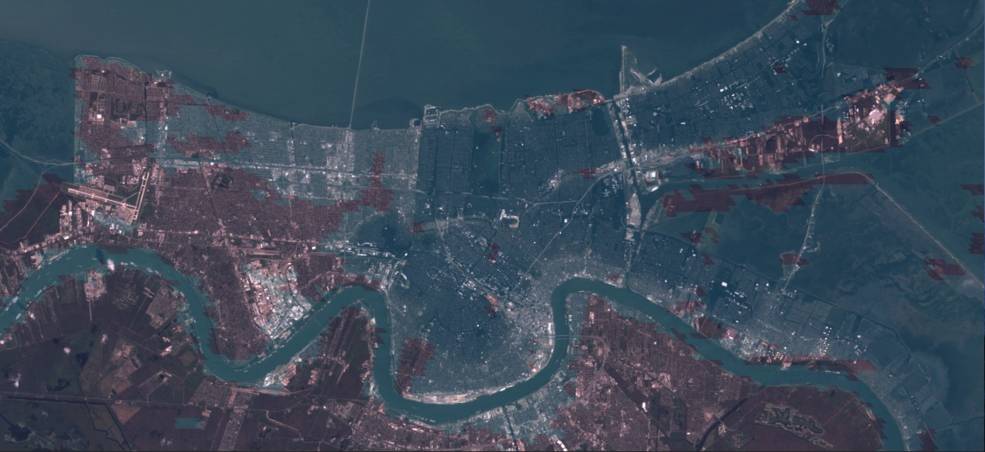
Building on a 50-year-old partnership, NASA and the U.S. Geological Survey (USGS) are expanding their cooperation with the relocation of one of the largest USGS science groups in the western United States to NASA Ames Research Center.
Both agencies are looking forward to reinforcing their close partnerships to study our planet from orbit to core. The possibilities enabled by bringing together scientists and engineers from the nation’s top agencies for earth, space and aeronautic sciences are enormous.
Over the next five years, more than 300 USGS employees will make the move several miles south in Silicon Valley from their current Menlo Park campus to the nearby NASA Research Park.
The idea for NASA and the USGS to co-locate has been in the works for several years. On Nov. 1, 2016, Ames’ Center Director Eugene Tu and USGS Pacific Regional Director Mark Sogge signed an agreement to pursue the move officially.
The proximity of the two research communities will enhance their collaboration, fueling research on natural hazards, water resources, atmospheric science, climate change, and more. The move also will allow the USGS to invest more funding in science that otherwise would have been spent on San Francisco Bay Area rent.
“The U.S. Geological Survey is pleased to be moving towards closer partnerships with NASA,” said Sogge. “The USGS leads our nation’s Earth science and NASA leads research outside of our home planet. We will work together to improve the scientific understanding of the world around us to the benefit of people today and into the future.”
“The Ames co-location of two federal agencies with a shared mandate to observe and understand planet Earth offers a unique opportunity to catalyze new and impactful research that might otherwise not be pursued,” said Michael Bicay, Ames’ Director of Science.
The two agencies working together is nothing new. The USGS helped NASA prepare astronauts for their geological exploration of the moon, and the pair continue to collaborate on USGS’s Landsat 8 and preparations for the launch of Landsat 9, cornerstones of our nation’s multi-satellite, multi-decadal, Sustainable Land Imaging (SLI) program. SLI is a NASA-USGS partnership to develop, launch, and operate a spaceborne system that will provide researchers and other users with high-quality, global, continuous land-imaging measurements.
Joint projects of NASA Ames and the USGS already under way include repurposing a space shuttle tile-inspection device for the study of soil density and landslide risk, and improving satellite tracking of wildlife. Observing the movements of animal populations can provide important information on the state of ecosystems and on public health threats, such as the avian flu. NASA designed the original USGS satellite-monitored wildlife tags in the 1950s. Currently, a team at NASA Ames has made them less cumbersome for the animals by building a lighter battery—technology that also will contribute to NASA’s development of small satellites.
Ian Brosnan, a marine scientist and special assistant to the director of Science at Ames, said he also looks forward to the two groups joining forces on more ambitious projects, such as exploring ways to use small satellites and aircraft to study complex coastal areas with high resolution in space and time.
“If we can’t devote the big satellites to this, perhaps we could do it with many small ones, and for less cost,” Brosnan said.
Much like the potential of those multiple small devices—much greater than the sum of its parts—NASA and USGS researchers will team up to tackle some of the big challenges ahead.
NASA Associate Administrator for Science Speaks at Ames
Profiles in Education: Little Things Make Big Things Happen
by Ruth Dasso Marlaire
Born and raised in the San Francisco Bay Area, Ruchi Pandya grew up surrounded by exciting innovation and new technologies. She always wanted to be a part of the Silicon Valley culture. She loved (and continues to love) the science research that develops and progresses new technologies to improve the quality of life for people everywhere.
Pandya attended Lynbrook High School in San Jose, California, and graduated in June 2015. During her senior year in high school, she participated in the Volunteer Internship Program at Ames, where she was given her first opportunity to work in a nanotechnology research laboratory. Under the supervision of Jessica Koehne, she started working to develop a carbon nanofiber-based cardiac sensor. The sensor uses a single drop of blood to detect changes in a patient’s protein concentrations. With this information, health professionals will have the potential to successfully diagnose and predict a cardiac arrest. Pandya believes this sensor has the potential to revolutionize in-home cardiac diagnostics as well as aid in crew health monitoring.
To better understand the sensor’s material base, she learned to characterize the carbon nanofiber using highly sophisticated technology and various research methods and processes. She used a scanning electron microscope, various voltammetry techniques and electrochemical impedance spectroscopy to detect the cardiac biomarker protein. The device works by first immobilizing protein antibody probes on the carbon nanofiber electrodes, and then introduces the blood sample to the carbon nanofiber system. The electrochemical data collected is used to determine troponin-I and cardiac reactive protein concentrations.
Today, she is a sophomore undergraduate student at the California Institute of Technology in Pasadena, California, where she is pursuing a double major in computer science and business, economics and management.
“Caltech strongly believes in collaborative culture and it is fun working on challenging problem sets together,” she said.
Pandya started working as a researcher in 2012 as a summer intern at the Water and Sanitation Management Organization in Gujarat, India. After the internship, she worked at Stanford University in Palo Alto, California, to develop a nanotechnology-based water purification filter designed to effectively and inexpensively remove impurities from water for both rural and developed community applications. That is when she realized, she was really interested in nanotechnology and its vast range of versatile applications.
She is appreciative of the opportunity she was given to work at Ames, where she learned the power of collaboration and resilience. She has not completely “chalked out” her future, but she hopes to work with a NASA facility.
“The Voluntary Internship Program at Ames was one of the most eye-opening and rewarding experiences I have participated in thus far, and it has largely shaped my personal and professional life,” she said.
Luxembourg Royalty Visit and Tour Ames Facilities
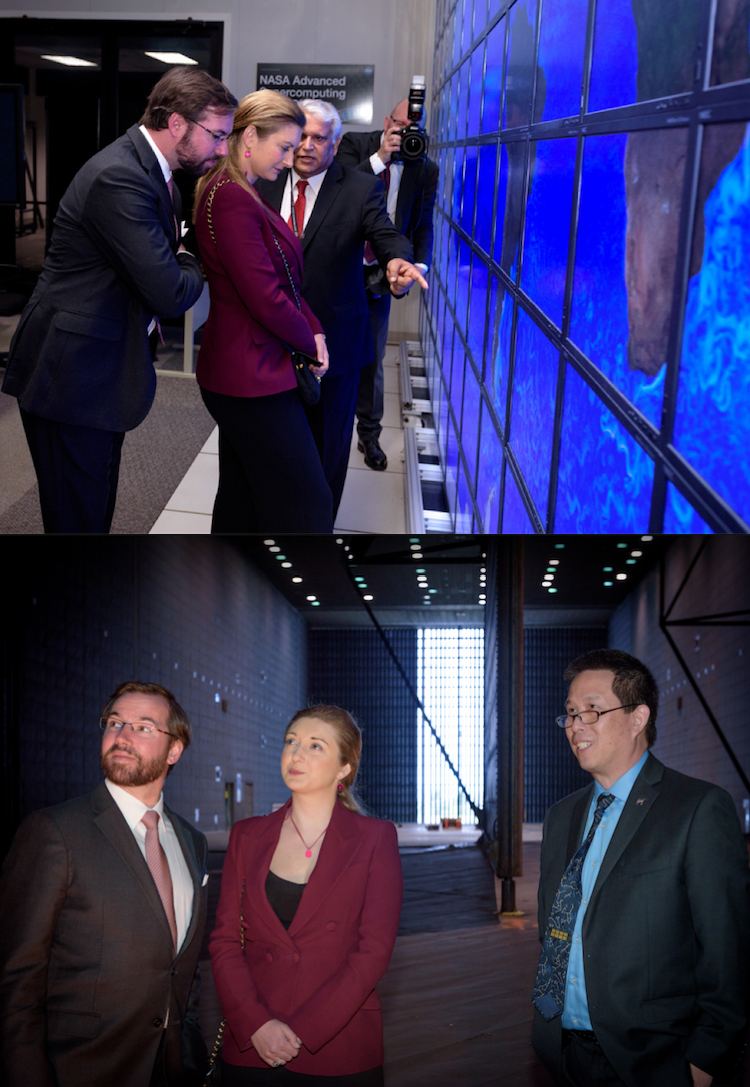
Venkatapathay Presents Seminar, “Weaving Our Way Around the Solar System”
Ames Associate Fellow Dr. Ethiraj Venkatapathy, chief technologist for the Entry Systems and Technology Division at Ames, spoke April 6, 2017, at the center presenting the seminar, “Weaving Our Way Around the Solar System.”
Exploration from afar is limited. Understanding requires external observations combined with insight of the inner workings. Entry, descent and landing (EDL) technologies are critical to explore the surfaces of other planetary bodies with atmospheres. NASA Ames is a leader in the development of technology to conduct atmospheric entry on different worlds, including re-entry to Earth.
During the seminar, Venkatapathy discussed emerging new technologies and computational methods that will facilitate the development of multifunctional EDL systems capable of withstanding extreme entry environments.
The Ames Associate Fellow is an honorary designation given to a NASA Ames employee in recognition of their scientific or engineering research excellence and contribution to NASA and to Ames. Venkatapathy was named the 2014 Ames Associate Fellow for his expertise and contributions in the area of thermal protection system (TPS) and materials.
Currently, Venkatapathy leads the game changing thermal protection system (TPS) materials development project funded by the Space Technology Mission Directorate as its project manager. He also is the chief technologist for both the adaptable, deployable entry placement technology (ADEPT) project and the Asteroid Threat Assessment Project (ATAP).
Norcal VA Subaru Members Visit Ames

In Memoriam …
Former Mathematician and Computer Programmer Marion Legg Passes Away
Marion was born Nov. 6, 1947 in El Paso, Texas to Jean Blocher Legg and Douglas James Legg. The family moved to Menlo Park, California in 1949 and settled in Ladera, where Marion was raised, and graduated from Woodside High School. Upon earning her mathematics degree from the University of Oregon in 1969, she returned to the Bay Area and began her 44-year career as a mathematician and computer programmer in the Space Sciences Division at NASA Ames.
Marion worked on the Apollo 12 magnetometer experiment as a programmer with Ames leads Palmer Dyal and Curtis Parkin. The instrument flew to the moon on Apollo 12 (1969), 15 (1971) and 16 (1972). After working on other space projects , she joined Lenny Pfister and the Ames Meteorology Group in 1983, to analyze data from radiosondes, aircraft and satellites to better understand the nature of atmospheric gravity waves, convection, ozone depletion and cirrus clouds. Marion continued this work for the rest of her Ames career until she retired in 2013.
In the late 1980s, Marion became involved in the series of NASA high-altitude aircraft measurement campaigns investigating ozone depletion. In all, she participated in 12 aircraft missions devoted to this critical issue by providing supporting meteorological satellite data to the field scientists running these missions. Although the scientific focus of NASA’s Upper Atmosphere Research Program changed in the early 2000s from ozone depletion to cirrus cloud and water vapor studies, Marion’s skills were still in demand and she continued to provide meteorological support, including the construction of a web site for the Ames Meteorology Group. She went on to support another 12 aircraft field missions, with her final one being the Airborne Tropical Tropopause EXperiment (ATTREX) in 2013.
Marion is remembered by her colleagues as a very hardworking and loyal person who could be relied on in difficult situations. Meteorological support involves handling large amounts of data and producing near-operational products in real time for tight planning schedules. When glitches occurred (and they always do), she was always willing to get up in the middle of the night and fix the problem. She was a consummate professional with selfless dedication to the success of Ames’ scientific projects. She also was kind, friendly and thoughtful–personality traits that endeared her to all who worked with her. An indefatigable fan and longtime season ticket holder of the San Francisco Giants baseball team, she is often remembered for the trips to the ballpark she would organize for her colleagues and friends in the Earth and Space Sciences divisions. Her dedication to the Giants paid off in 2010 when they finally won the World Series. She was ecstatic.
We missed her when she retired in 2013, and we will miss her even more now. While part of Ames’ unique culture has passed into the ages, her memory will remain forever in our hearts.
Marion’s passion for baseball extended to the Ames community as well. She was a long time member of the “Dregs” Softball team, and its manager for several years, recruiting players, lugging bat bags and playing catcher. She was always an enthusiastic participant in the after game beer and pizza parties. She was a regular in the Ames Bowling League and also was an officer in the Foothill Women’s Bowling Association. Marion also golfed and was a member of the Ames Golf Club and Women’s Evening Golf Club at Deep Cliff in Cupertino.
Marion also enjoyed competing in activities such as Ballroom Dance and Duplicate Bridge. Embroidery and painting ceramics were among her quieter endeavors. Marion also had a passion for genealogy while tracing her family history and volunteered at the Menlo Park Family History Center to help others in tracing their past. She had a sincere appreciation for animals: her joy of travel often revolved around her fascination of whales. Marion was a giving and caring person who was always there to help others.
Marion is survived by her father Doug and his wife Patari; sister Kimberly; brothers Jim and David; sister-in-law Mary; nephews Benjamin, Christopher and Alexander and a host of dear friends.
The family has requested donations be made to the Susan G. Komen breast cancer charity in honor of Marion Legg’s memory. http://ww5.komen.org/donate
A celebration of life event was held April 19, at the Ladera Recreation District, 150 Andeta Way, Portola Valley, California. You can get more details and post photos, thoughts or contribute at:
marion.legg.muchloved.com
California Spring Wildflowers Blooming in front of Mega Bites Cafe at Ames





























